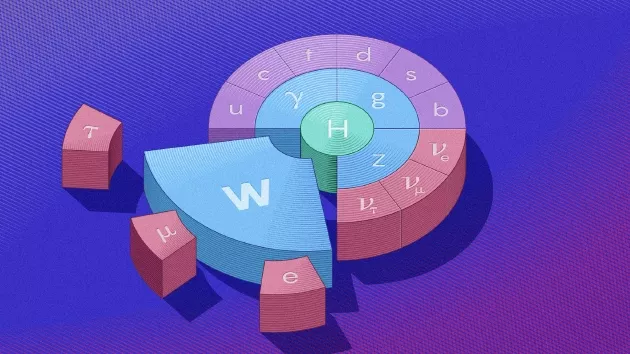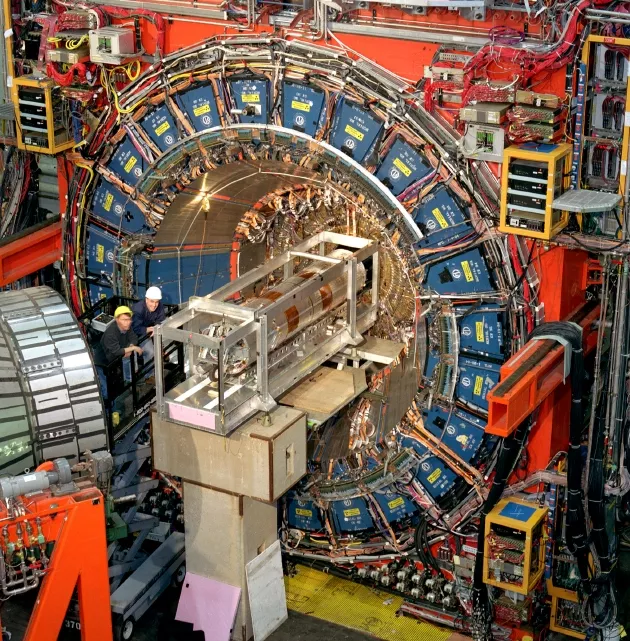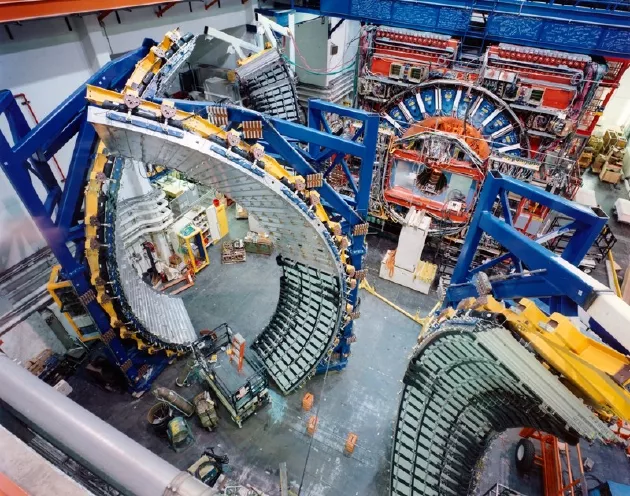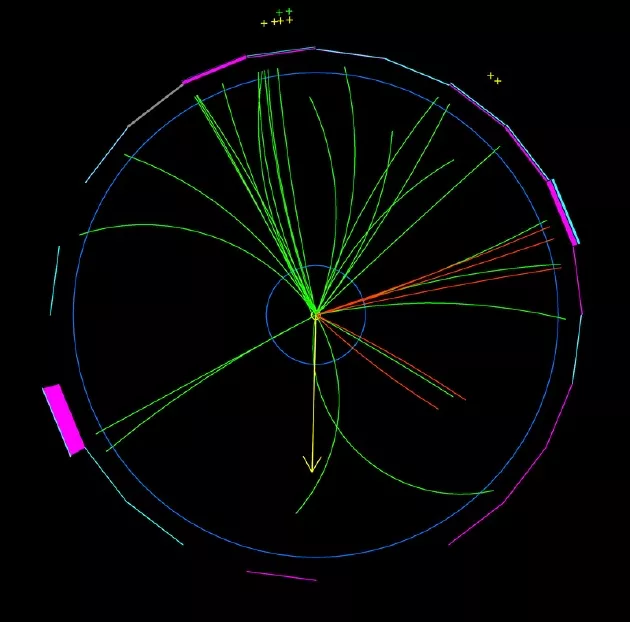On May 9, Beijing time, according to foreign media reports, the latest analysis of the w boson mass shows that these particles are much heavier than the predicted value of the standard model in particle physics. Physicists found that this basic particle that transmits weak nuclear force seems to be 0.1% heavier than previously predicted, and it is this small difference that may herald a major change in basic physics. The relevant research results were published in the recent journal Science.

The w boson is one of 17 known elementary particles, and its peculiar mass measurement results may point to unknown particles or forces.
The latest measurement of the w boson comes from the Tevatron, an old-fashioned particle collider at the Fermi National Accelerator Laboratory in Illinois. This is a particle accelerator built in 1983 and closed on September 30, 2011. After that, about 400 members of the Fermilab collider detector (CDF) cooperation project continued to analyze the w boson generated by Tevatron and track countless possible error sources to achieve an unparalleled level of accuracy.
If the w boson is "0.1% overweight" relative to the predicted value of the standard theory can be independently confirmed, it will mean that there are some particles or forces in the universe that have not been discovered by us. The laws of quantum physics in half a century may usher in the first major rewriting, which will completely change the way we look at the world. The Higgs boson fits well with the previously known picture, but this discovery will open a new field. If the new results are verified, their significance may even be comparable to that of the Higgs boson discovered in 2012.
At present, the physics community is eagerly looking for the defects of the standard model of particle physics, and this discovery is just in time. The standard model is a set of equations describing the three basic forces of strong force, weak force and electromagnetic force and the basic particles of all matter. It has occupied a dominant position in particle physics for a long time, covering almost all known particles and forces. However, the standard model is still considered incomplete, and there are still many unsolved mysteries to be explained, such as the properties of dark matter. The good record of CDF cooperation projects makes their new measurement results quite credible, which poses a challenge to the standard model.
However, no one has opened champagne to celebrate. Although the new w boson mass measurement results are quite different from the prediction of the standard model, the results of other measurement experiments are not so remarkable (although not accurate). For example, in 2017, the atlas experiment of the European Large Hadron Collider (LHC) measured the mass of the w boson and found that it was only a little heavier than the predicted value of the standard model - only equivalent to the weight of a hair. The inconsistent results between CDF and Atlas showed that at least one team ignored some subtle quirks in the experiment.
If the CDF result is confirmed, researchers also want to understand the difference between it and previous measurements. The w boson on on both sides of the Atlantic must be the same. This is a landmark work, but it is difficult for us to know how to deal with it.
W boson

The CDF project is one of two experiments carried out at different locations on the 6.3 km ring of Tevatron particle accelerator. The figure shows the installation process in 2001.
W boson and Z boson are the basic particles responsible for transmitting weak nuclear force. They were discovered in 1983 and are considered to be a great victory of the standard model. The w boson is named after the "weak" of the weak nuclear force. Weak nuclear force, also known as weak interaction or weak force, is one of the four basic forces of the universe. Unlike gravitation, electromagnetic force and strong nuclear force (strong interaction), weak nuclear force does not push or pull much, but converts heavier particles into lighter particles. For example, a μ The meson spontaneously decays into a w boson and a neutrino, and then the w boson decays into an electron and another neutrino. The associated subatomic deformation produces radioactivity, a process that allows the sun to shine continuously.
Over the past 40 years, researchers have measured the mass of W and Z bosons through various experiments. Facts have proved that the mass of W boson is a particularly attractive research goal. When the mass of other particles is simply measured and accepted as a natural fact, the mass of W boson can only be predicted by combining some other measurable quantum properties in the standard model equation.
For decades, experimental physicists at Fermilab and other research institutions have been using the connection network around the w boson to try to detect other particles related to it. Once researchers have accurately measured the items that have the greatest impact on the mass of the w boson - such as the strength of the electromagnetic force and the mass of the Z boson - they can begin to detect other factors that have less impact on its mass.
In this way, physicists predicted the mass of a particle called the top quark in the 1990s. The top quark interacts with other elementary particles through strong force and decays into w boson and bottom quark through weak force. In 1995, physicists detected and determined the mass of the top quark. In 2000, physicists repeated this feat: they predicted the mass of the Higgs boson before it was discovered.
However, although theoretical physicists have various reasons to expect the existence of top quarks and Higgs bosons and connect them with W bosons through standard model equations, there is no obvious missing part of today's theory. Any difference in the mass of the w boson points to the unknown.
Measuring the mass of the w boson

The Tevatron particle collider at Fermilab was once the most powerful accelerator in the world.
The latest measurement of W boson mass by CDF project is based on the analysis of about 4 million w bosons produced by Tevatron between 2002 and 2011. When Tevatron uses protons to hit antiprotons, w bosons often appear in the subsequent chaos. Then the w boson decays into a neutrino and a μ Mesons or electrons, both of which can be detected directly. μ The faster a boson or electron is, the heavier the w boson that produced it.
Ashotosh kotewal, a physicist at Duke University in the United States, is the driving force behind CDF's recent cooperative analysis. His career has been devoted to perfecting this framework. The core of the w boson experiment is a cylindrical chamber with 30000 high-voltage wires μ When mesons or electrons pass through them, these high-voltage wires react, allowing CDF researchers to infer the path and velocity of particles. Knowing the exact position of each wire is the key to obtain the accurate trajectory of particles. In their new analysis, kotvar and his colleagues took advantage of cosmic rays falling from the sky μ Meson. Like bullets, these particles pass through the detector in an almost perfect straight line, allowing researchers to detect any unstable wires and fix the position of the wires within 1 micron.
Researchers also spent years conducting detailed cross checks between data releases and repeating measurements in an independent manner to ensure a full understanding of each of Tevatron's characteristics. At the same time, the measured values of W boson accumulate faster and faster. The latest analysis report of CDF was released in 2012, covering the data of Tevatron in the first five years. In the next four years, the amount of data quadrupled. "It's coming like water from a fire hose, faster than you can drink," cottvall said.
Nearly ten years after the last analysis, the CDF cooperation project finally released the results. At a zoom conference in November 2020, kotvar pressed a button to decrypt the team's results (they used encrypted data so that the numbers did not affect their analysis). The physicists here fell silent and seemed to be thinking about what these results meant. They found that the mass of the w boson was 80.433 billion electron volts (MeV), with an error of about 9 MeV. This makes it 76mev heavier than predicted by the standard model, which is about 7 times the measurement or prediction error.
Scientists usually use several Sigma to judge the importance of a measurement. When the sigma exceeds 5, scientists are confident to announce that they have made a deterministic discovery, and the measurement result of CDF reaches "7 Sigma", which can be said to be a very clear result. However, the low measurements of atlas and other experiments forced the researchers to stop.
Is the new measurement wrong, or does it mean a new breakthrough

The particle collision computer image of Fermilab CDF detector shows that a w boson decays into a positron (magenta block at the bottom left) and an invisible neutrino (yellow arrow).
With the closure of Tevatron, the responsibility for confirming or denying the CDF measurement results falls on the Large Hadron Collider (LHC). In fact, the device has produced more w bosons than Tevatron, but its higher collision rate makes the analysis of W boson mass more complex. However, by collecting more data - possibly at lower beam intensities - the LHC is expected to solve these problems in the coming years.
At the same time, theoretical physicists had to start thinking about what the "overweight" W boson might mean. One μ When mesons decay into electrons, they will briefly release w bosons, which can interact with other particles, even with undiscovered particles. This interaction with unknown particles may make the mass measurement of W boson deviate.
Another possibility is that the heavier w boson may be caused by another Higgs boson, which is more inactive than the Higgs boson we know. Alternatively, this may be because a new large mass boson mediates a variant of a weak force, or a "composite" Higgs boson composed of multiple particles, which is combined by a new force.
Some theoretical physicists suspect that the anomaly of W boson mass can be derived from the particles predicted by supersymmetry theory. Supersymmetry theory is a framework that has been studied for a long time. It connects material particles with particles with carrying capacity, and assumes an undiscovered opposite type of particle - or "partner" (fermion supersymmetric particle) for each known particle. However, scientists have been unable to find supersymmetric particles in the Large Hadron Collider, and the supersymmetry theory is no longer popular, but some theoretical physicists still believe that the theory is correct.
Sven heinmeyer and his collaborators recently calculated that some supersymmetric particles can solve another phenomenon that is assumed to be inconsistent with the standard model, that is μ Sub G-2 is abnormal. In this way, these particles may also increase the mass of the w boson slightly, although it is not enough to match the measurement results of the CDF. "It's interesting to help us study the particles of G-2 and possibly the mass of W boson," he said
The hard work of experimental physicists in precision measurement makes researchers more optimistic that the long-awaited breakthrough is coming. In general, physicists are approaching the moment of breakthrough and are approaching to truly surpass the standard model. (Ren Tian)